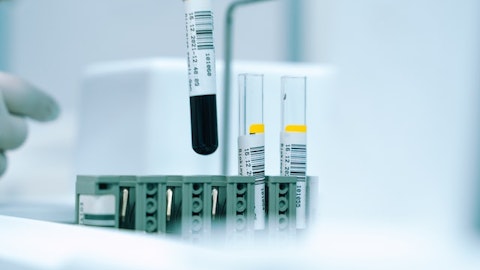Alpine Immune Sciences, Inc. (NASDAQ:ALPN) Q4 2023 Earnings Call Transcript March 18, 2024
Alpine Immune Sciences, Inc. isn’t one of the 30 most popular stocks among hedge funds at the end of the third quarter (see the details here).
Operator: Ladies and gentlemen, welcome to the Alpine Immune Sciences Fourth Quarter 2023 and Full-Year Earnings Call. Currently, all participants are in a listen-only mode. As a reminder, this event is being recorded. And I would now like to introduce Temre Johnson, Senior Director of Investor Relations and Corporate Communications at Alpine. Ms. Johnson, please go ahead.
Temre Johnson: Thank you, Ravi. Good afternoon, and thank you to everyone for taking the time to join us today. With me on today’s call from Alpine are Dr. Mitchell Gold, Executive Chairman and Chief Executive Officer; Dr. Stanford Peng, President and Head of R&D; Paul Rickey, Chief Financial Officer; and Dr. Remy Durand, Chief Business Officer. Before I turn the call over to Mitch, I’d like to remind you that we’ll be making forward-looking statements during today’s call. These forward-looking statements represent our views as of today and are based on our current expectations and consequently involve risks and uncertainties. Actual results could differ materially from those anticipated in such forward-looking statements as a result of such risks and uncertainties. I encourage you to refer to the most recent SEC filings regarding the risk factors associated with these statements. Mitch, please go ahead.
Mitchell Gold: Thank you, Temre, and thank you all of those who are participating in the webcast today. 2023 was a transformational year for Alpine with initial IgA nephropathy data presented at the American Society of Nephrology’s Kidney Week suggesting a best-in-class profile of povetacicept, our wholly-owned next-generation dual BAFF/APRIL inhibitor with once-monthly dosing developed using our direct evolution platform. We are still only in the early stages of exploring the full potential of povetacicept. On the back of strong enthusiasm around ASN, we closed an oversubscribed $150 million equity offering to accelerate multiple development activities. With our encouraging data set in IgAN, convenient once-monthly dosing regimen, a strong balance sheet, we are rapidly advancing development of POVI as a potentially meaningfully new therapeutic option for patients living with IgAN, lupus, and multiple other autoimmune and inflammatory diseases.
Looking ahead, we are well positioned for meaningful catalysts in 2024 and beyond. In April, we plan to present additional data on povetacicept in IgA nephropathy, including the follow-up data from the 80-milligram monthly and initial data from the IgAN 240-milligram monthly dose cohorts at the Royal Congress of Nephrology meeting next month. Following this data, in the second half of the year, we plan to initiate RAINIER, a pivotal Phase 3 study of povetacicept in IgA nephropathy; and DENALI, a Phase 2 study of povetacicept in SLE. In addition to updates on our clinical studies, we look forward to sharing translational data that further supports the best-in-class potential of povetacicept in multiple diseases. I’ll now hand the call over to Stanford to review our progress and provide updates on our development plan for povetacicept in more detail.
Stanford?
Stanford Peng: Thank you, Mitch. As Mitch has described, the emerging clinical findings with povetacicept continue to inspire us to advance as rapidly as possible. At last year’s Kidney Week meeting, we reported the first clinical observations with povetacicept in IgAN, where it was associated with a greater than 50% reduction from baseline in proteinuria at six months as measured by urine protein-creatinine ratio or UPCR. In addition, the majority of patients met remission criteria as defined as a reduction in UPCR of less than 0.5 grams per gram, at least a 50% reduction in UPCR from baseline and stable renal function as assessed by estimated glomerular filtration rate or eGFR. Importantly, these findings were associated with significant reductions in a key IgAN biomarker, Gd-IgA1, supporting the concept of povetacicept as a disease-modifying therapy.
As a reminder, the improvable efficacy target has historically been a 30% reduction in proteinuria at nine months. Our very encouraging findings continue to hold up with additional agents and with longer follow-up, povetacicept could indeed be a particularly compelling therapeutic option for patients with IgAN and other autoimmune diseases. Therefore, since ASN, we’ve been making every effort to prepare the program and the company for the next pivotal stage of development. We look forward to the opportunity to provide a formal clinical data update on povetacicept in IgAN next month at the World Congress of Nephrology, which will take place in a late release poster. In the meantime, our primary development goal for povetacicept is its advancement this year to a pivotal trial IgAN, which we’re calling RAINIER.

Of course, several other autoimmune and/or inflammatory disease indications remain of great potential interest for povetacicept. First, lupus remains a key indication, second only to IgAN, supported by the clinical validation of the pathway efficacy by BAFF inhibition and wild-type TACI IV molecules. We continue to plan to initiate a Phase 2 study in lupus called DENALI later this year. Second, we continue to explore other renal indications in the RUBY-3 study. At last year’s Kidney Week, we described a single patient with primary membranous nephropathy, or pMN, would achieve an immunological remission of povetacicept. Such a finding suggests that other autoantibody-related diseases may benefit from povetacicept. Indeed, we continue to enroll additional subjects with pMN.
And as a reminder, RUBY-3 is also enrolling lupus nephritis and has just recently opened an ANCA-associated vasculitis cohort. In addition, we continue to explore autoimmune cytopenia in the RUBY-4 study. We look forward to future opportunities to share these collective data. Finally, ongoing and emerging preclinical and translational data continue to suggest yet additional therapeutic areas like neurology or allergy for povetacicept. Last year at Kidney Week, we observed a significant reduction in IgE in IgAN patients who have received povetacicept, suggesting potential applicability in IgE-related diseases like allergy. We also presented data on povetacicept in a mouse model of myasthenia gravis at the American Association of Neuromuscular and Electrodiagnostic Medicine Annual Meeting.
And next month, we will present data on povetacicept in a mouse model of autoimmune encephalitis at the American Academy of Neurology meeting. In the myasthenia models, povetacicept appeared superior to clinically relevant comparators such as SCR inhibition or B-cell depletion. We this may in part be related to some unique biophysical and/or other developmental characteristics of povetacicept, which confirm greater tissue penetration and/or distribution than wild-type TACI-Ig. Data supporting this latter statement will be part of a poster later this week at the European Lupus meeting. All together, these developments only reinforce the potential for povetacicept to have broad clinical impact in multiple serious diseases. As a reminder, povetacicept was discovered in-house by our proprietary direct evolution protein engineering platform, which has been quite productive and continue to generate novel drug candidates that may be of great future interest.
We therefore look forward to opportunities to provide further updates not only on povetacicept but also on our development pipeline in the near future. I’ll now turn the call over Paul Rickey, our Chief Financial Officer.
Paul Rickey: Thank you, Stanford. And now I’ll provide a brief overview of our financials for the year ended December 31, 2023. For the year ended 2023, collaboration revenue was $58.9 million compared to $30.1 million for the same period in 2022. The increase in collaboration revenue relates primarily to a $24.9 million increase in AbbVie revenue, of which $20.4 million is due to a cumulative catch-up adjustment resulting from the completion of enrollment and synergy for the amendment with AbbVie, and a $4.5 million increase in Amgen revenue, driven primarily by the expiration of Amgen’s option to select a third research program. These increases were partially offset by a $0.6 million decrease in Adaptimmune revenue as we completed our final deliverables under the agreement in June 2023.
Research and development expenses for the year ended 2023, inclusive of non-cash expenses, were $80.9 million and $70.2 million for the same period in 2022. The increase of $10.7 million was driven by an $8.2 million increase in povetacicept costs primarily related to higher clinical, process development and manufacturing expenses, a $1.3 million increase in acazicolcept costs due primarily to process development and manufacturing, and a $7.7 million increase in personnel-related costs. General and administrative expenses for the year ended 2023 were $22.2 million compared to $18 million for the same period in 2022. The increase of $4.3 million was primarily attributable to increases in personnel costs and professional services. The company recorded net losses of $32.2 million and $57.8 million for the year ended 2023 and 2022, respectively.
As of December 31, 2023, Alpine’s cash and investments totaled $368.2 million, which we anticipate should be sufficient to fund our planned operations into 2026. I will now hand the call back to Mitch.
Mitchell Gold: Thanks, Paul. As Stanford highlighted, we are highly encouraged by the initial IgAN data for povetacicept and are just beginning to explore the full potential of this unique, potentially best-in-class molecule. We look forward to a catalyst-rich year with data update in IgAN and other indications and the planned initiation of RAINIER, our pivotal Phase 3 study in IgAN; and DENALI, our Phase 2 study in SLE. In addition, we continue to evaluate the potential for povetacicept in additional indications. And as Stanford mentioned, we continue to invest in our immunology discovery efforts to advance the next generation of programs from our direct evolution platform. With that, I’ll turn the call over to the operator for questions.
See also 10 Best Commodity ETFs and 15 Best Blockchain and Bitcoin ETFs.
Q&A Session
Follow Alpine Air Express Inc (OTCMKTS:ALPN)
Follow Alpine Air Express Inc (OTCMKTS:ALPN)
Operator: [Operator Instructions] And we will take our first question from Tara Bancroft with TD Cowen.
Tara Bancroft: So I have a question on ITP expectations. So first, can you provide some potential conferences that the data might be presented, like how you mentioned for the kidney data, it might be at two different ones during the second half? I know you’ve leveled it down but just some granularity around potential venues. And then what level of efficacy you’re looking for to potentially start a Phase 3 study?
Mitchell Gold: So for RUBY-4, Tara, I think you — we look at it as just ITP. I mean, we have interest in other indication beyond just ITP. So obviously, you have ITP. We have cold agglutinin disease. And our goal is to be, as we mentioned, to be able to present that data in the first half of this year. So we haven’t yet determined which conference that’s going to be at, but there’s a couple that we have our eye on in that. And you had one other question. Remind me what that was again? That’s what we want to see in ITP. Yes. I’ll remind you that these are highly refractory patients, so they’re third- or fourth-line therapy patients. So I think that we saw a meaningful improvement in platelet count really like that 20% response rate that would that could be meaningful for us.
Operator: And we will take our next question from Mike Ulz with Morgan Stanley.
Mike Ulz : Maybe two on IgAN and the update at WCN. Can you maybe give us a sense of how many patients we should expect at the 80- and 240-milligram dose and the level of follow-up? And then maybe secondly, just what’s your current thinking about selecting the go-forward dose? And what would you need to see at the 240-milligram dose to bring that one forward?
Mitchell Gold: Yes. Thanks, Mike. So for WCN, what you should anticipate seeing is, for the first time, we’ll get a look at 9-month data at the 80-milligram dose cohort level. Obviously, the 9-month data is really important because that endpoint the regulators used for an accelerated approval. And I’ll remind you that the benchmark there historically has been a 30% reduction in UPCR. And in six months, we were seeing over 50% reduction in UPCR. In addition to WCN, you’ll get your first look at the 240-milligram data. We expect that to be a relatively small number of patients thus far and with limited follow-up but we will get a first look at 240. As we look at things now, things we need to look dramatically better with 240 over 80.
At 80 milligrams, we’re already seeing best-in-class reductions in proteinuria, and that continues to hold itself up at nine months. We think we have a very clean path forward at the 80-milligram dose level. But if 240 will exceed that, that obviously would be excellent for the company and for patients themselves.
Operator: And we will take our next question from Thomas Smith with Leerink Partners.
Thomas Smith: And looking forward to seeing the data updates at WCN next month. Can you just remind us what your expectations are with respect to the 240-milligram dose relative to the strong 80-milligram dose data that we’ve already seen now at three and six months? Should we be looking for deeper or perhaps more rapid reductions in proteinuria at these earlier time points? Or are you expecting to see similar reductions with the 240-milligram dose?
Mitchell Gold: Yes. I’m sure Stanford is going to want to add on to this. But what I would say initially is I’ll remind you that if you go back to our healthy volunteer data at 80 milligrams we’ve covered APRIL for about three weeks, and then we lost coverage even though we covered BAFF and continuum. So the 80-milligram data so far continues to look best-in-class. It’s still early at 240 milligrams. It’s something that we’re going to continue to track to get a quick peek at it at WCN. And then we’ll have additional follow-up that we can share of 240 through as we move throughout the course of the year. We will answer, as we mentioned, have a presence at ERA in May. So we look forward to sharing additional data and presentation at time here. Stanford, I don’t know if you want to add on to that at all in terms of dosing at 240.
Stanford Peng: I think you covered it.
Mitchell Gold: Anything else, Tom?
Thomas Smith: Got it. That’s helpful. Yes. And then just in terms of continuing to enroll IgAN patients in RUBY-3 at that 240-milligram dose, is the expectation here that you’re going to keep enrollment open until you can get the Phase 3 RAINIER trial off the ground later this year? Or is there a target enrollment that you’re looking for? And I guess maybe lastly, how much overlap is there between the RUBY-3 trial sites and the planned site for RAINIER?
Mitchell Gold: So what I can tell you is that after we shared the data at ASN at Kidney Week last year, enrollment in the RUBY-3 IgAN cohort has been incredibly robust. In fact, we have exceeded our enrollment expectations at the 240-milligram cohort. So there’s been a tremendous amount of investigator interest and a tremendous amount of patient interest participating in the RUBY-3 trial. I think that’s a testament to the fact that these patients want disease-modifying treatments that are going to alter their disease. So we’re pretty excited about that. In terms of the overlap, there will be some overlap there in terms of the sites that are in RUBY-3 and what we’re doing for our pivotal RAINIER trial. But I would also emphasize, we’re kind of really a bit of a perfect situation where we expect that both Phase 3 studies that are ongoing in IgAN right now will be wrapping up enrollment just as we’re launching our Phase 3.
So we anticipate that we’ll be the only Phase 3 trial there enrolling during that time frame. So hopefully, that will take for a fairly robust enrollment time line for povetacicept in this RAINIER study.
Operator: And we will take our next question from Gregory Renza with RBC Capital Markets.
Unidentified Analyst: Congrats on the progress. This is [indiscernible] on for Greg. I have a question on RUBY-4. Could you remind us the rationale? And if you have any preclinical evidence that BAFF and APRIL should work synergistically or additively in this indication and if they are better than the current standard of care?
Mitchell Gold: I’ll let Stanford take that. Stanford?
Stanford Peng: Yes. There are several published studies demonstrating elevated levels of BAFF/APRIL in various cytopenias, in many cases, correlating with disease activity or the severity of the cytopenia. We actually showed in some of our preclinical publications last year that in some preclinical models, for example, in the New Zealand black light lupus model, which includes an autoimmune hypoglycemia manifestation that treatment with povetacicept can be beneficial and similarly have shown that in such models that inhibition of both BAFF and APRIL such as with povetacicept or other dual inhibitors can be superior to either cytokine alone. So that’s why it’s actually some of that preclinical data that is to look at these indications.
And then, of course, there’s the general rationale that there’s a heavy dependence on B cells. And I may just also remind you, those studies also been prepared against some standard of care therapeutics like B cell depletion, at least in the translational or clinical models.
Operator: We will take our next question from Matt Biegler with Oppenheimer.
Matt Biegler: Do you guys plan to provide any analysis on antidrug antibody development or ideally lack thereof at WCN, I guess, maybe to address some of the nagging questions on immunogenicity?
Mitchell Gold: Yes. We have not seen any clinically significant ADA to data. That’s on there. Obviously, we’re continuing to monitor. And as we have a more complete data set, we’ll share that as we update on bogey’s development.
Matt Biegler: Is it also possible maybe with further follow-up that ostensibly, if the data matured nicely that we can kind of put that idea to rest?
Mitchell Gold: I think one, this is different than a lot of other recombinant proteins that are administered subcutaneously in the sense that the mechanism of the drug actually is almost designed to inhibit ADAs. So in a certain sense, it’s something that POVI kind of sets itself up well for. But I think if you look at the data that we’ve seen today, and you’ll see the 9-month data that we presented at WCN, we’re not seeing anything of clinical significance coming up.
Operator: And we will take our next question from Joe Pantginis with H.C. Wainwright.





